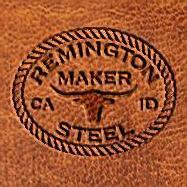-
Content Count
102 -
Joined
-
Last visited
About MedusaOblongata
-
Rank
Member
Profile Information
-
Location
Oregun
Recent Profile Visitors
7,185 profile views
-

History of Sewing Machines & How They Work
MedusaOblongata posted a topic in Leather Sewing Machines
I just found this video about the history of sewing machines and how they operate. It's old news to our experts here, but I still found it instructive and interesting: -

what do people use to block RFID in Wallets?
MedusaOblongata replied to ToddW's topic in How Do I Do That?
Tl;DR: RFID blocking is not at all necessary for security. It's just a marketing feature for a wallet maker. I do leatherwork as a hobby but my day job is in the credit card department of a bank. Theft via portable RFID scanners had been becoming a major issue at one point, you could walk through a crowd of people with a scanner in a briefcase and from several feet away capture people's credit card information, which could then be used to make transactions. My bank stopped offering paywave as a feature on their cards. A few years later they reintroduced that feature on newer cards. I contacted our fraud department directly and asked why they would do this, considering the security risks we saw materialize last time. They got back to me and explained some of the features in the reintroduced RFID system. While the old ones could be read at a greater distance, current ones must be within 3 inches or less from the machine. The old ones gave out the card number itself, which is what thieves can use; the new ones work like the EMV chip, that does not give out the 16 digit card number, but instead generates a one time use code that only works for that one transaction. If anyone were to scan your card now, all they'd get is a one time use code that's already been used and they can't even use it for a single transaction. This is also what merchants get when you insert your card to use the EMV chip, the merchant never gets your actual card number (which is reusable), they get a code that works only once for that transaction. This way if the merchant's system is hacked, the hackers don't get CC#s they can use, they just get used up codes they can do nothing with. You don't need RFID blocking for security at all. It might be worth advertising it if your customers think it's a good idea, even though it won't improve their security. -
MedusaOblongata started following Pendleton Leather Show
-
MedusaOblongata started following How to get the smoothness back?, Things I've Learned From Leather Working, Don't You Hate It When..... and and 3 others
-

Things I've Learned From Leather Working
MedusaOblongata replied to CTaylorJr's topic in Leatherwork Conversation
This is doubly true when the material in question is removed from your hide. If you spill something (coffee, beer, soda, dye, oil) on your project, carry it to the sink and pour the remainder of the drink on the project, then rinse it clean, hoping for uniform coverage so it will all match. Do not use this technique when what you've spilled on your project is blood. Most new "help me out" questions can be answered with one of two answers: Test it on scrap first. Let it dry overnight. -
Just after sharpening and stropping my knife, I've slipped while cutting and the knife bounced off my hand without cutting me. I'm simultaneously relieved to be uninjured and disappointed my knife didn't do a better job.
-
I had some crocodile skins that were so dry and hard I was afraid I'd crack them if I bent them. I gave the top side a coat of olive oil and a day and a half later the skins were supple and flexible. It may darken the crust, but it should soften it.
-
JLS - that is beautiful!
-
Use a wax based shoe polish, melt it in with a heat gun, then buff it until it's shiny and your arms hurt. This will give it that non-porous top coat.
-
Is that the same as cold tape used to prevent stretching like this: https://www.amazon.com/Lanas-Fabric-Cold-Tape-Black/dp/B018JO5FDA ? I've done similar things for sure, have to stop, take it apart, try again. Done it more than once. Hopefully it's a lesson learned well about paying attention to detail. I've got on my workbench a nice leather tray I use for rivets or screws or spare parts for whatever I'm working on that's painstakingly carved and antiqued with a customer's wrong initials. I noticed after it was done and it made more sense to make him a new one than to try to fix it, so now I get to keep the mistake as an aid to memory. When we're lucky, we laugh at ourselves instead of getting upset.
-

Looking for Input on Machine Choices
MedusaOblongata replied to Rubicon04's topic in Leather Sewing Machines
Do you have a link to that aluminum top? -
Did you make the video?
-

Is there a reasonably priced leather supplier recommendation
MedusaOblongata replied to Mulligan31's topic in Suppliers
I second the recommendation for https://www.springfieldleather.com/ Their prices range from fair to cheap, they've got a huge variety of different types of leather as well as tools. Their youtube videos are pretty helpful too. -
I just got back from an international trip and my wallet carry requirements were quite different from what they are at home. This is a good idea. I'll remember to do something similar before my next international trip.
-
I picked up a copy of that issue there, and signed up for a subscription. It was a really great show and I learned a lot in the classes I took. If anyone's on the fence about going to a show like this one, definitely go whatever you have to do to make it possible. Being able to learn directly from some of the best leatherworkers in the industry, talk leather with more people like us, and buy tools and leather in person, are all spirit-lifting and inspiring.
- 15 replies
-
- veterans
- leatherworker
-
(and 3 more)
Tagged with:
-
Start with a dollar bill and a credit card, figure you want it to hold a dozen or two of each, and build it around that. Then look at the back pocket of a pair of pants and figure you want it to fit in there. Then create some designs.





